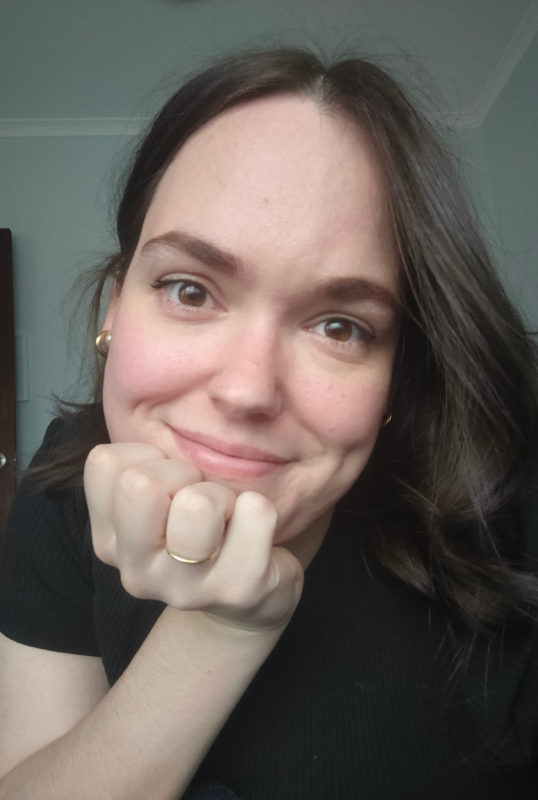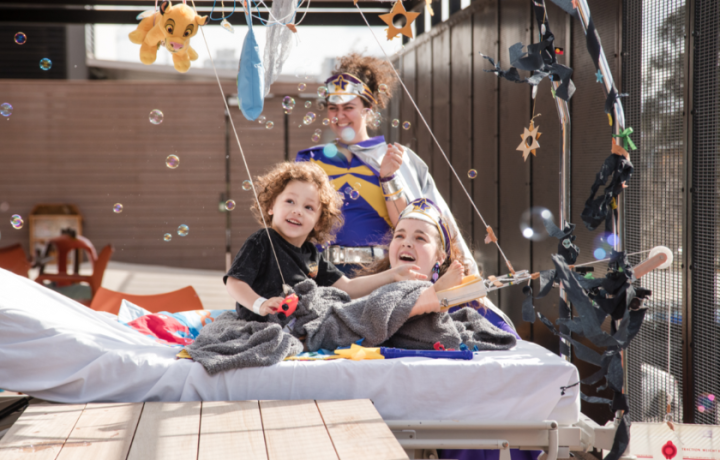Breaking the silence: New online clinic offers hope for eating disorder recovery

Posted on
Content warning: eating disorders.
When Jane Murphy was nine years old, she would sit down and record her habit of restricting food during the Christmas holidays in her diary.
In fact, there was never a time when the now Canberra resident didn’t have a difficult relationship with her body.
Distinctly remembering being five years old and feeling dissatisfied with her body, Jane says that there were several different factors that led to her more than decade-long battle with an eating disorder.
Growing up in the late 1990s and early 2000s – a uniquely fatphobic time in cultural history – along with difficult childhood experiences including significant body shame from a close family member, an OCD diagnosis and strong sensory processing differences, for Jane, living in her body felt like going to war with herself.
With noise coming from all directions – like the bombs of fatphobic comments about the rolls in her five-year-old thighs and the squeal of being a woman in a larger body during the heroin-chic fashion era – she says the combination was the “fire that lit the kindling.”
“I remember having this adult in my life looking at a picture of me and making a comment about how fat my thighs were when I was probably four or five years old…it was relentless,” she says.
“There were constant negative comments about my body, food and even other people’s bodies…All that goes into this young impressionable person’s brain and becomes a part of the way that they think about themselves in the world. That’s absolutely what happened for me.”
Slipping through the cracks

Jane, age 19.
Eating disorders and disordered thoughts about food have always existed. From historical descriptions from the time of Caesar in 700 B.C, where rich ancient Romans would gorge themselves at lavish banquets and then purge so they could return to the feast, to the creation of websites like Tumblr in the 2000s that allowed “thinspo” content to spread like wildfire, the serious and potentially life-threatening mental illnesses have impacted people for centuries.
And while eating disorder trends have consistently plagued pop culture and social media, according to the Butterfly Foundation, the prevalence of eating disorders in Australia has only increased in the last decade. With over 1.1 million Australians currently experiencing an eating disorder, data shows that fewer than a third are getting treatment and more than 73 per cent of young people ‘never’ or ‘rarely’ talk to someone when they’re feeling bad about their body or appearance.
For Jane, it took five years to realise that her relationship with food wasn’t normal or healthy. But it wasn’t until she was 22 that she started to receive treatment.
“I had this health class where they talked about different kinds of mental health conditions that people experience, and that included a discussion about anorexia and bulimia,” she explains.
“They talked about the different kind of behaviours and patterns of thinking that are involved with anorexia and bulimia, and I thought ‘That is 100 per cent me’. But the teacher – and I hold grace for this, because teachers have so many different pressures on them – concluded by saying, and the problem with that intense restriction, or the bingeing and purging cycle is that you might get too skinny and then die.”
As a self-described physically larger woman who went through puberty early, she says she remembers hearing that comment and thinking “My eating disorder is telling me that I am so enormously fat, so that’s not something I actually have to worry about.”
“It took a really long time for me to unpack that one moment of ‘No, I can be sick and not extremely underweight’,” she says.
By the time people are ready to seek treatment, many don’t know where to start or where to look. For others, financial barriers and long wait lists mean the support they can access is limited. And with many people – like Jane – unable to receive in-patient treatment because they don’t fit the physical indicators needed for hospitalisation, they slip through the cracks.
“There is no healthy amount of eating disorder to have.”
Jane met all the criteria for anorexia nervosa except for being underweight. Suffering from physical symptoms including hair loss and constant feelings of sickness and hunger, the isolation she felt because she didn’t “look” like someone with an eating disorder felt like yet another battle.
But the moment she decided to reach out and seek help is one she’ll remember forever.
“There are a couple of things that led me to getting help. I was getting help for long-term depression, and I came to a point where I realised I couldn’t deal with my depression without acknowledging this other stuff that’s going on,” she says.
“The other part of it was building a stable and happy life with my then boyfriend and now-husband… An eating disorder, it has so many impacts on your body, on your emotions, on your ability to connect with other people. It’s so destructive.”
But not only was Jane then living in a regional area with limited treatment options available, but she also experienced bias from eating disorder professionals.
“My GP was amazing and helped me through a bunch of things, like the fact that I was experiencing severe nutritional deficiencies – which is not surprising given over 10 years of restrictive eating. But the first psychologist I saw was not a good fit for me, and really caused quite acute distress,” she explains.
“There is no healthy amount of eating disorder to have, and there is no situation in which it is healthy for you to have an eating disorder or a disordered relationship with food… It’s so clear, not just in the eating disorder space, but just in health in general, that someone’s size and shape often has very little to do with whether they’re healthy or not.”
For Jane, recovery wasn’t a linear process. On average, recovery from an eating disorder takes between one to six years, but it’s a deeply personal journey that looks and feels different for everyone. And while there are many new residential treatment facilities in Australia – including one in the ACT – a new, groundbreaking, government-funded online service is making support for eating disorders accessible to everyone.
Care is just a click away

Jane in 2025.
The InsideOut Institute’s e-Clinic – in partnership with Sydney Local Health District – offers self-paced programs, including specialised treatment for binge eating and bulimia nervosa, alongside support for carers and a healthcare professional hub.
Designed for people over the age of 16 who spend a lot of time thinking about weight or shape, who restrict food or feel a loss of control around food, the self-help tools and programs are free to access without a referral or diagnosis.
Supported by comedian and author of All I Ever Wanted Was To Be Hot, Lucinda Price (AKA Froomes), the launch of the e-Clinic offers a safe space for people to seek help.
“When I was unwell, I had absolutely no idea where to start looking for help. This eClinic is a much-needed safety net…for many people, this will be a lifeline,” she wrote in The Guardian.
“Hundreds of thousands are still stuck in silence, still waiting, still falling through the cracks. The fact that the government has seen the merit in this treatment is significant. It’s time we moved the dial.”
Jane says that she is grateful for the support she received during her recovery journey – but she admits she wishes she also had access to something like this.
“When I came around to realising I did have an eating disorder, the landscape of things that were freely and easily available was extremely limited. I remember almost obsessively checking the resources that were on the Butterfly Foundation website,” she says.
“A thing that is important for me is it was hard to get support because of my shape and size, because of where I was located, and because of my financial situation. But there are also things like being LGBTQ+ where the relationship between you and the medical system might be different, or you come from a different cultural background,”
“Having a resource that can meet you where you’re at and you can engage with it in a place where you are safe and comfortable and don’t have to worry about some additional pressures is so magical.”
Breaking down barriers to eating disorder treatment across Australia, for many people, the resources available at the e-Clinic will be life-changing. And while it’s not suitable for people in a medical emergency or psychological crisis, Sarah Cox, manager of Butterfly National Helpline and clinical psychologist, says early intervention like what the e-Clinic offers can have a major difference in recovery.
“Eating disorders are complex mental illnesses. There is never one cause of an eating disorder – an eating disorder develops due to a combination of biological, psychological and sociocultural factors,” she explains.
“While recovery is possible at any stage of illness, we do know that early intervention can have a marked difference on an eating disorder’s severity and duration – individuals who receive early intervention for an eating disorder are twice as likely to achieve recovery.”
For Jane, recovery now looks like peace, joy and spontaneity around food. And for anyone who is questioning their relationship with food and thinking about seeking help, she says if one door shuts, keep knocking until others open.
“It’s something that I have like gotten to experience as an adult that I never got to experience as a child,” she says.
“It is so joyful to be recovered or in recovery…For anyone who is considering getting support for an eating disorder, once you start doing the work, it’s a lot easier to be recovered or recovering than it is to live with it.”
Monday 1 until Sunday 7 September is Body Image and Eating Disorder Awareness Week – a national event to raise awareness of body image concerns and eating disorders. For confidential and free support for eating disorders call the Butterfly National Helpline on 1800 ED HOPE (1800 33 4673) or visit butterfly.org.au to chat online or email.
For more information about the InsideOut Institute’s e-Clinic or to access its services visit eclinic.insideoutinstitute.org.au

